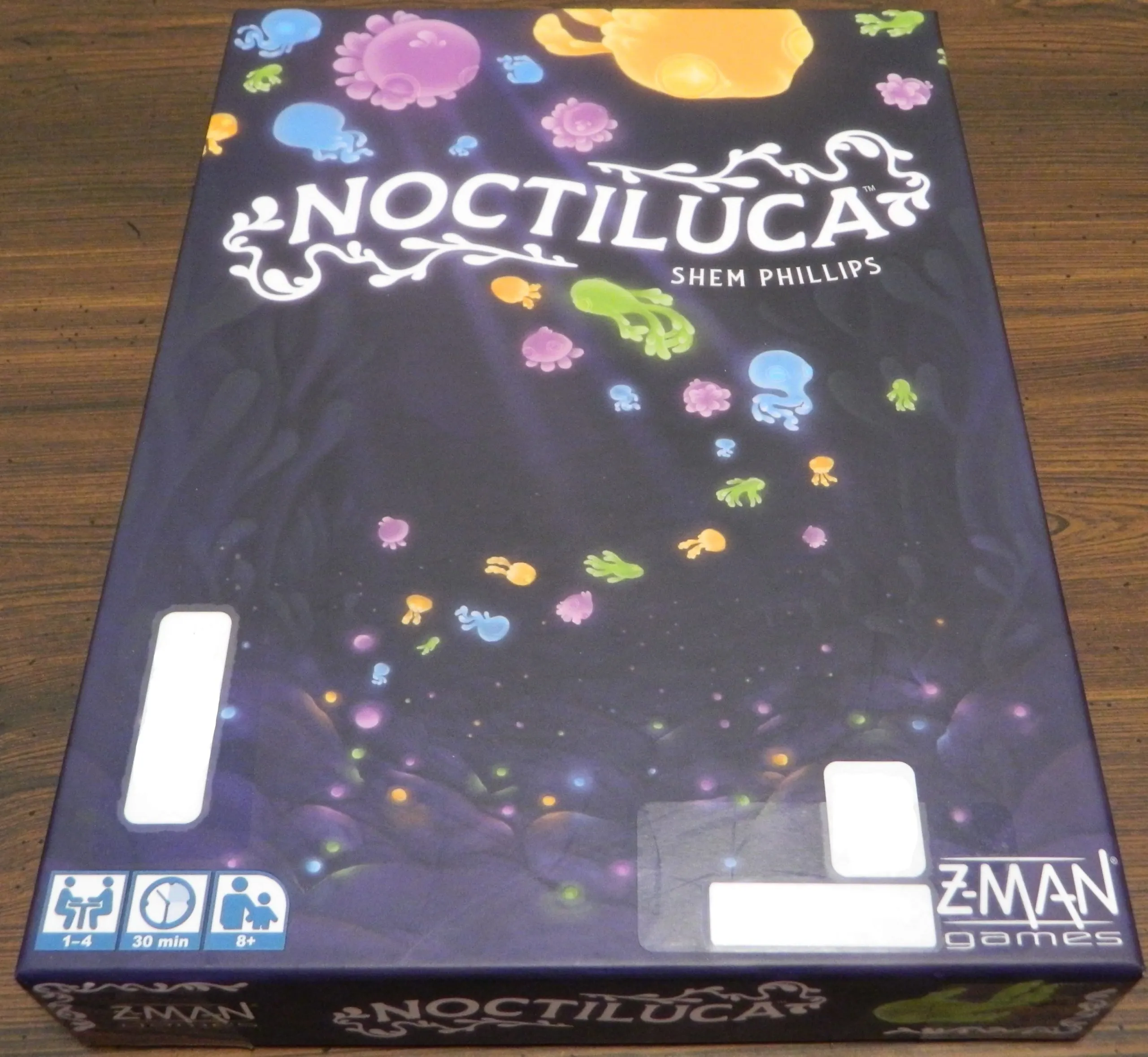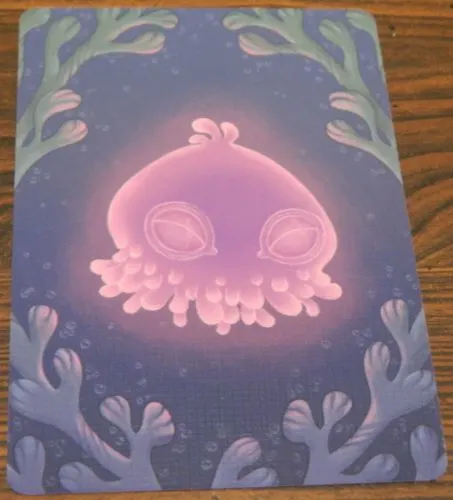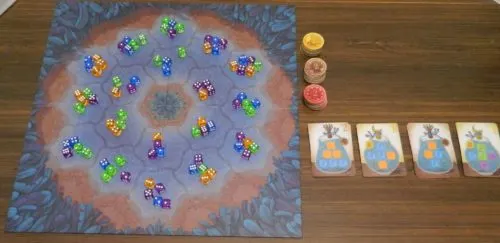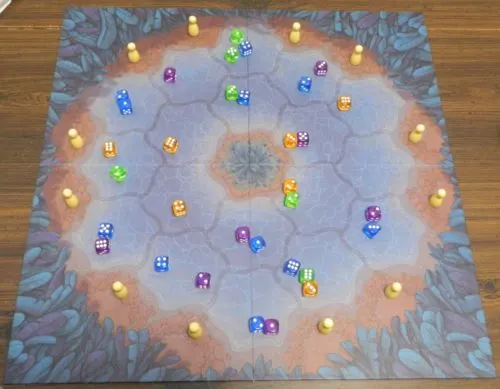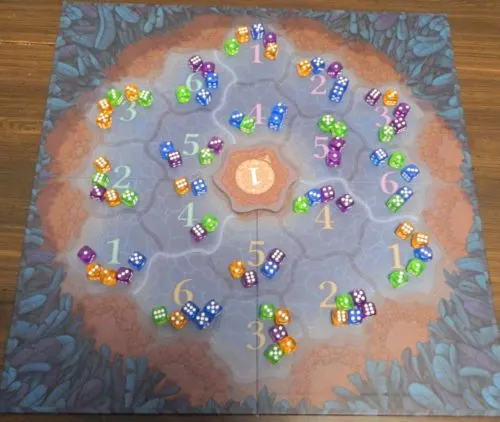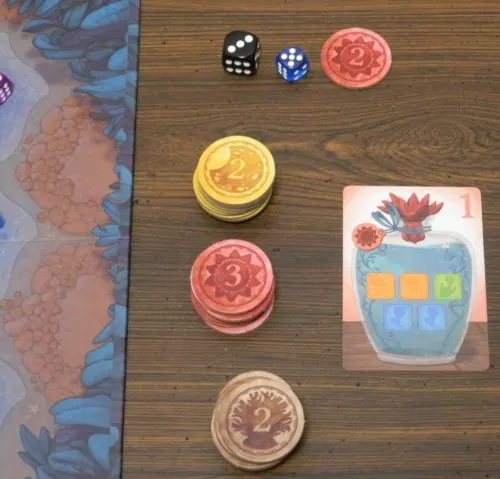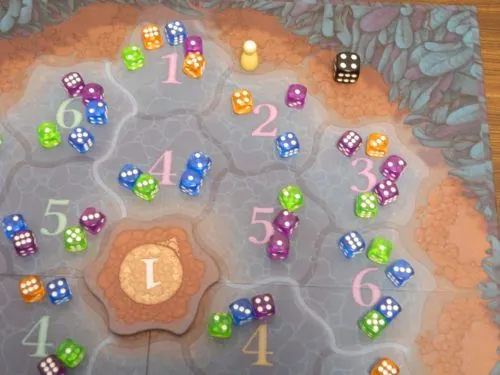With the number of different board games that I have played and reviewed, it is sometimes hard to find a game that has some genuinely original mechanics. Most games either follow the exact same formula or add their own little twists on pretty typical formulas. Rarely do I find a game that has a mechanic that I haven’t really seen in another board game before. This brings me to today’s game, Noctiluca, which intrigued me because it genuinely sounded like a unique idea. Noctiluca is a unique game that hides quite a bit of strategy compared to its simplicity, but it sometimes suffers from a serious analysis paralysis problem.
How to Play Noctiluca
Setup
- Place the gameboard in the middle of the table with the numbered side face down. The numbered side is used for the solo game (for more information see the Solo Game section below).
- Randomly draw dice (not the black die) and place them on random spaces on the gameboard. Randomization is key to the game so it should be random which color dice and what numbers are on each space. Each inner space should have four dice while the outer spaces should have five dice. Once the dice are placed you should not move or adjust them.
- Distribute the twelve pawns equally between the players.
- Separate the point tokens by their color. Each color will then be sorted with the highest values on the bottom and the lowest values on the top. These stacks should be placed near the gameboard.
- Shuffle the favorite cards and deal one to each player. Each player should look at their card without letting the other players see it. The players will score bonus points for each nocticula they collect during the game of the color on their favorite card. Any remaining cards are returned to the box.
- Shuffle the jar cards and deal three to each player. Each player will look at their cards and choose two to keep. The extra cards are shuffled with the rest of the cards.
- Separate the remaining jar cards into four faceup piles. The cards should be distributed as evenly as possible.
- The youngest player will start the game and will be given the first player marker. They will turn this marker to the “1” side.
Selecting Noctiluca
Noctiluca is played over two rounds with each round consisting of 12 turns.
To begin their turn the current player will analyze the spaces along the edges of the board where a pawn has yet to be played. The player will choose one of these unoccupied spaces to place one of their pawns on.
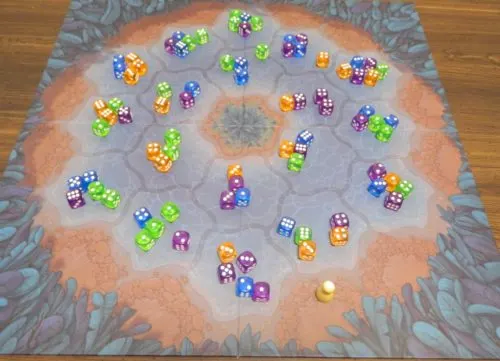
The first player has placed their pawn on the gameboard. They will be able to take dice in the path going straight up from where they placed the pawn or they can take dice from the outer row next to where they placed the pawn.
If they choose the left path they have the following options:
Ones – 3 green, 1 purple
Twos – 1 blue, 1 purple, 1 green
Threes – 1 purple, 1 orange
Fours – 2 blue, 1 green
Fives – 1 purple, 1 blue
Sixes – 1 purple
If the player chooses the up path, they will have the following options:
Ones – 1 blue, 1 purple
Twos – 1 orange, 1 green, 1 blue
Threes – 2 orange, 1 purple
Fours – 2 orange, 3 purple
Fives – 1 purple
Sixes – 2 blue, 1 green, 1 purple
After placing their pawn the player will choose one of the two straight paths that are adjacent to the space that they played the pawn to. They will also choose a number between one and six. The player will collect all of the dice on their chosen path which match the number they chose.
Storing Noctiluca
The player will then place the dice they retrieved onto their jar cards. Each dice can be placed on a space that matches its color. Once a die is placed it cannot be moved. The player can choose to play dice to one or both of their cards.
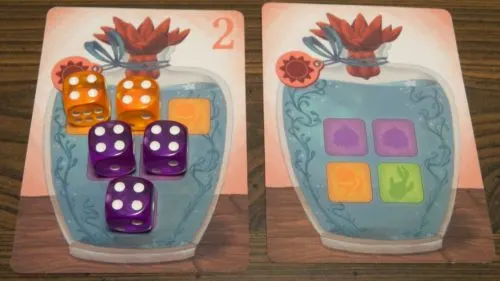
During their turn this player acquired three purple and two orange dice. They chose to play all five dice on the left card. They could have chosen to place up to two of the purple and one of the orange dice on the right card.
If the current player was unable to use all of the dice they collected, they will pass them to the next player in turn order (clockwise for the first round). If the next player can use one or more of the dice, they will choose one to add to one of their cards. If there are dice remaining, they will be passed to the next player in turn order. This continues until all of the dice have been placed on a player’s card. If there are any dice that can’t be used they will be returned to the box.
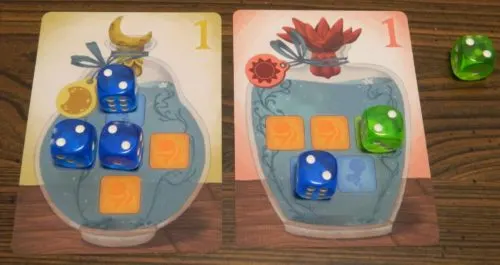
This player acquired an extra green dice that they were unable to place. The die will be passed to the next player who will have the chance to add it to one of their cards. If they can’t use it, it will pass to the next player and so on. If none of the players can use it, it will be returned to the box.
Completing Jars
When the current player has completely filled in one or both of their jar card, they will deliver the jar(s). They will take all of the dice from the jar and return them to the box. They will then take the top token of the type shown on the jar’s tag, and place it color side up in front of themselves. The jar card will then be flipped face down.
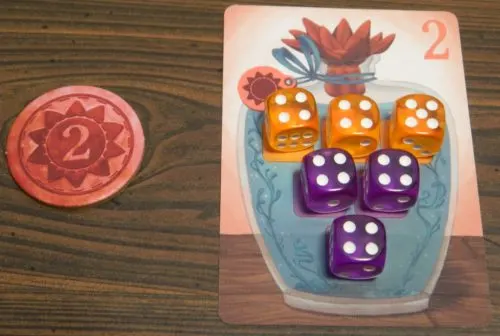
This player has placed a dice on all of the spaces on this jar card. They have completed this card. They will take the top token from the red pile as it matches the tag on the jar card. This card will then be flipped over and will score points at the end of the game.
The player will then get to choose a new jar card from one of the face up piles. If they finished both jars they will take two new cards. If a pile ever runs out of cards, that pile will remain empty for the rest of the game.

As the player completed one of their jar cards, they will get to take one of these four cards from the middle of the table.
If a player other than the current player completes a jar card from a die that is passed to them, they will also deliver their jar in the same way as the current player. If multiple players complete jars in the same turn, players will complete the action in turn order starting with the current player.
End of Round
The first round will end once all of the pawns have been placed on the gameboard.
All of the pawns will be removed from the gameboard, and will be evenly distributed to the players.
All of the dice still on the gameboard are removed from the game. The board is then refilled with new dice from the box in the same way as during setup. If there are not enough dice to completely refill the board, you should distribute the dice as evenly as possible.
The first player marker is then turned to the “2” side. The marker will be passed to the player who placed the last pawn in the first round. Turn order for the second round will move in a counter-clockwise direction.
End of Game
The game ends after the second round.
Players will count up how many point tokens they received from each of the three colors. The player who collected the most tokens of each color (number of tokens not value of tokens) will get to take all of the remaining tokens of that color. Before taking the tokens, they will be flipped to the other side as these tokens will only be worth one point each. If there is a tie for majority, the remaining tokens will be evenly split between the tied players. Any extra tokens will be returned to the box.
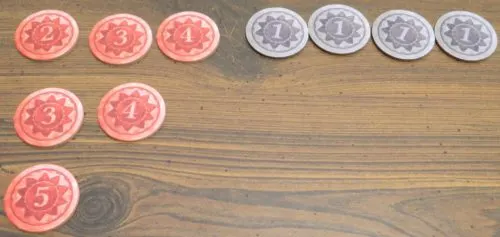
The top player acquired the most red tokens (3), so they will get the remaining red tokens that weren’t taken by a player. These tokens will be turned to the gray/one side.
Players will then tally their final scores. Players will score points from four different sources.
Players will add up the points on each of their point tokens. Point tokens taken during the game will be worth the number printed on the color side. Bonus tokens taken after the game has ended will be worth one point.

This player acquired these tokens during the game. They will score 27 points (2 + 3 + 4 + 4 + 3 + 4 + 3 + 1 + 1+ 1 + 1) from the tokens.
Each player will then count up the numbers (top-right corner) on the jar cards that they completed. They will score the corresponding number of points. Cards that weren’t completely filled will not earn these points.
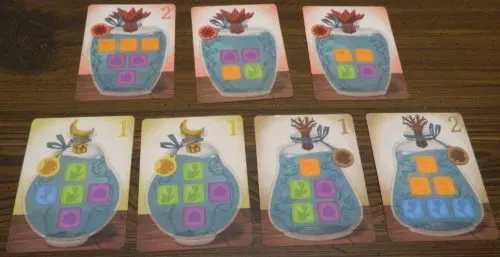
This player completed these jar cards during the game. They will score seven points (2 + 1 + 1 + 1 + 2) from the cards.
The players will then flip over their favorite card. Each player will score one point for each space of that color on their delivered jar cards.
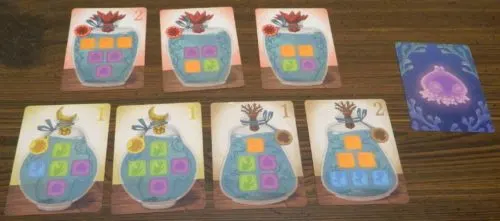
This player’s favorite color was purple. During the game they completed cards that feature twelve purple spaces so they will score twelve points.
Finally players will score one point for each two dice that they have remaining on their jar cards that they couldn’t complete.
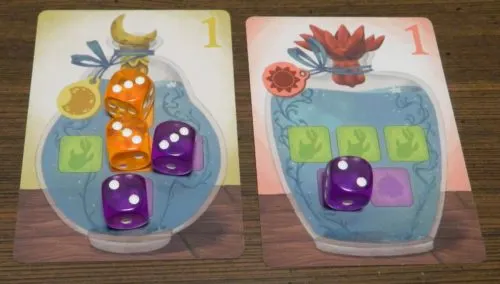
This player had five dice remaining on the cards that they weren’t able to complete. They will score two points for the dice left on these cards.
The players will compare their final scores. The player who scores the most points wins the game. If there is a tie, the tied player that completed the most jar cards wins the game. If there is still a tie, the tied players share the victory.
Solo Game
Noctiluca has a solo game which mostly follows the same rules as the main game. Changes to the rules are noted below.
Setup
- Place the gameboard with the number side up.
- The black die is placed near the gameboard.
- The player will only use six of the pawns for each round.
- Instead of four piles of jar cards, all of the jar cards will form one facedown deck.
- The first player marker will be placed in the center of the gameboard. The arrow on the marker will point towards the purple section of the board.
Playing the Game
Choosing which dice to add to your jar cards is the same as the main game. Any dice that you take that you can’t use though are placed next to the black die in what is referred to as the “Tempest. You will lose points at the end of the game for each die in the Tempest.
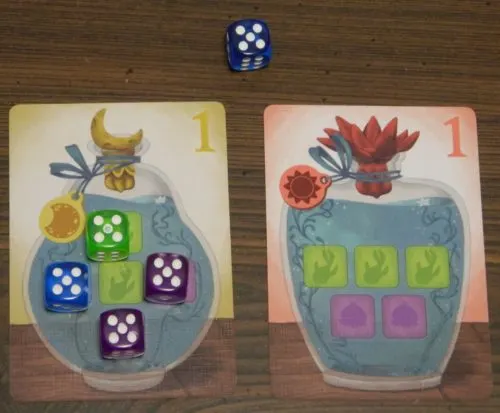
The player took five dice during their turn. They couldn’t use one of the blue dice so it will be added to the Tempest.
When you complete a jar card, you will draw the top two cards from the deck. You will choose one to keep and the other will be returned to the bottom of the deck.
The Tempest
After each player’s turn you will perform some actions for the Tempest.
- The top card from the jar deck is discarded.
- The top point token from the color matching the jar card that was discarded will be added to the Tempest.
- You will look at the first player marker to figure out which is the current section of the board. You will then roll the black die. You will remove all dice from the current section of the board that match the number that was rolled. These dice are returned to the box.
- The first player marker will be rotated to the next section of the board. In the first round it will be turned clockwise. In the second round it will be turned counter-clockwise.
End of Round
After you have placed your sixth pawn and taken your turn, the game will move onto the second round.
All pawns will remain on the board. In the second round you will have to use the spaces that you didn’t use in the first round.
End of Game
The game ends after you have placed all of the pawns.
To determine majorities for the three point token colors, you will compare the tokens you have taken to the tokens in the Tempest. If you have a majority of a color, you will take the remaining tokens and flip them to the one point side. If the Tempest has more of the color, the tokens will be turned to the one side and will be given to the tempest.
You will then count up how many points you have scored following the same process as the main game. You will then count up the Tempest’s score. It will score the points shown on their point tokens as well as one point for each die. You will then subtract the Tempest’s points from the points you scored. If the difference is positive one or more, you win the game. If the difference is zero or a negative number, you have lost the game.
My Thoughts on Noctiluca
I have played close to 1,000 different board games, and I have to say that I don’t recall ever playing a game quite like Noctiluca. It shares some things in common with games like Azul, but that isn’t a great comparison either. Basically the objective of the game is to acquire the color dice pictured on your jar cards. You do this by choosing one of the unoccupied spaces along the edges of the board and one of the paths that extend from that space. You are mostly looking for a group of dice of the colors that you are looking for that are all the same number. The more dice of colors that you need that you are able to gather on your turn, the more likely you are to finish a jar card and get started on a new card.
Logically you would think that you would just want to take the path that has the most dice of the same number. You have to be a little picky though as you don’t want to take more dice than you can actually use. Any dice that you can’t use will be passed to the other players. Thus if you end up taking a lot of dice that you can’t use, you will help the other players almost as much as you help yourself. If you are able to get a lot of dice that help yourself though, it may be worth taking an extra dice or two as you will still gain dice over the other players. If you can’t get considerably more dice for yourself though, you are usually better off just sticking with paths that will only give you dice that you can use.
I have to say that it is kind of hard to explain what it is like playing Noctiluca. This is mostly because the main mechanics of the game aren’t that similar to other games that I have played. The game deserves credit for coming up with a pretty unique main mechanic. There are games that have some similar mechanics, but I can’t recall playing a game with the same combination of mechanics before. I enjoyed playing Noctiluca as it has some really interesting ideas behind it. The game mostly succeeds due to two factors.
First I found the game to be quite simple to learn and play. Despite the mechanics being pretty unique, the actual gameplay is quite simple. Basically you just pick a path and a number. You will then take all of the dice that match both. The ultimate goal is to pick dice that match the colors on your cards. The game will probably take a little longer to explain than your typical mainstream game, but I think you could explain it to most players within just a couple minutes. Because of this I think Noctiluca could work quite well as a family game. I think it could also work pretty well with people that don’t generally play a lot of board games.
With the game being pretty easy to play, I was genuinely surprised by how much strategy there is in Noctiluca. The game relies on some luck, but your fate will rely heavily on the paths that you end up taking. What path and number you choose will have a big impact on your own game as well as the other players. You need to put a lot of thought into what you choose in order to maximize the number of dice that you are able to take. In a way the game feels kind of mathy as you try to figure out the combination that will earn you the most dice. There is some real skill/strategy to the game as you should get better at it the more you play it.
There is more strategy than just the dice you end up taking though. What jar cards you end up taking can also have a pretty big impact on the game. There are a couple of different things that you need to consider before choosing a jar card. First it is always beneficial to choose a card that features your “favorite” color as each space of that color on your completed cards will score a bonus point at the end of the game. The second thing you should consider is whether the card is worth points itself or if the jar’s tag color is of a color that you are trying to collect. Jars with points on them are usually beneficial even if they can sometimes be harder to finish. As for tags, you pretty much should try to focus on one or two different colors. You should focus on specific colors in order to increase the odds that you will own of the majority of that color. This is key as you can score quite a few points if you are the majority leader of a color. Finally you need to consider whether the layout of the dice on the gameboard works well with a card. If you either already need to collect a bunch of the colors from the card or there really aren’t any beneficial combinations on the gameboard for a card, you are probably better off choosing a different card.
Probably the thing that I liked the most about Noctiluca is just that the whole idea behind the game is quite interesting. The game really forces you to think. In a way it kind of feels like a puzzle. You basically are trying to find a combination that can fill in as many of the spaces on your cards as possible. It really feels like every decision you make in the game has the potential to make a huge impact. One bad decision could be the difference between winning and losing. On the surface the game seems so simple, and yet there is real skill to doing well in the game. The best player will likely win most games. It is so satisfying when you are able to find a path that gets you four or more dice of colors that you need without giving dice to the other players. It is hard to explain exactly why, but Noctiluca is just really fun to play.
I don’t know if I would really consider this to be a positive or a negative. Basically Noctiluca can be kind of mean to players at times. The player interaction in Noctiluca is kind of limited, but when it comes into play you can really mess with another player. Basically the player interaction comes from choosing which spots and dice you take from the board. Normally you will probably choose the option that helps you the most. There will be times though where you might make a decision to mostly mess with another player. This can be done by either taking a path that another player wants, taking dice from the board that another player wants to take, or simply blocking the path so another player can’t claim it. Other players can have quite a bit of control over your fate by messing with your strategies. This seems to be worse in games with more players. The players will usually be affected pretty equally, but in some games one player could be messed with so much that they have pretty much no chance of winning.
There are a lot of things that I liked about Noctiluca. The game has one potential huge issue though. The biggest problem with the game is that it creates the perfect storm for analysis paralysis. Unless you have a keen eye your success in the game will be aided by how much time you spend looking for the best possible move for your turn. At least for the beginning of each round there are a lot of different things to consider. You have up to 24 different paths to consider with six numbers for each path. Therefore if you are looking for the perfect play each round it will take a long time to consider all of the different options.
The reason that it takes so long to consider all of the different options is there is just so much information to process. In a way all of the different colors look like a jumbled mess where it is kind of hard to focus on specific paths. You can limit the paths that you have to analyze by looking for colors that are featured on your cards. Even with this narrowing of options, there is still a lot to consider before you make your decision. This gets a little better as the round progresses since there are less paths open to you and there are less dice to analyze.
Making the analysis paralysis problem worse is the fact that there really isn’t much of a benefit to trying to analyze your options until it is your turn or the turn before yours. While you could build up a list of possible moves, you likely won’t remember all of them. The odds of another player messing with the move you want to make is also pretty high. They can either take the path for themselves, or take most of the dice that you wanted. This is one of the worst parts about the analysis paralysis in Noctiluca. As there really isn’t much of a reason to plan ahead, you are basically stuck sitting there waiting for the other players to make their choice. This makes the time that you have to wait drag on, and even the player whose turn it is can tell that the other players are waiting for them.
Normally I would recommend implementing a time limit for each player’s turn. This will help the analysis paralysis problem. If you implement this house rule though, players need to be willing to not take the game too seriously. On most turns there is a clear best move. If you can’t find the best move in time, you will hurt your chances of winning the game. When you miss that best move, it hurts as it feels like you ruined your chance of winning the game. A lot of people are going to want to take as much time as they need in order to find the best choice each turn.
Other than the analysis paralysis problem, Noctiluca also relies on some luck. Luck in the game comes from a couple of different areas. First it is really beneficial to have combinations of dice that you can take from the board that work well with your jar cards. Theoretically when choosing a new card you could analyze all of the dice combinations on the board to find the one that will be easiest to complete. This will add to the analysis paralysis problem though. Additionally some players will benefit from other players passing dice to them. At least based on our games not a lot of dice get passed as players minimized giving other people dice. It seemed like the same players ended up getting the extra dice over and over again though which gave them a distinct advantage in the game.
For these reasons I was actually curious to see how Noctiluca would play with less players. The game supports up to four players. With less players the analysis paralysis problem should be lessened as players could at least start thinking of options during the other player’s turn. The reliance on luck should be less as well since whenever the other player takes too many dice, they will be punished by helping their direct competition. Even the ability to mess with other players would be lessened as several players couldn’t mess with one player. It seems like most people prefer playing Noctiluca with less players.
For the most part I agree with this assessment as I think Noctiluca is better with two players than three or four players. I wouldn’t say that it is drastically better though as the four player game is still quite enjoyable. I preferred the two player game for a couple reasons. With only two players the analysis paralysis problem is reduced a decent amount. We actually came up with a little workaround to take more time to analyze options while letting the other player start to seriously think about what they wanted to do. Basically after a little amount of time had passed, the current player announced their intended move. This allowed the next player to start thinking of what they wanted to do. While they were thinking the current player could analyze different options and could change their mind if they came up with a better option. Once the second player choose their move though, the current player was locked into their original choice. I thought this helped speed up the game a little while also letting players take more time to analyze their options where they didn’t feel like they were rushed.
Other than reducing the analysis paralysis problem, the two player game also fixes some of the other problems with the game. It feels like you have more control over your fate in the game as you only have to rely on your own moves and one other player. The other player’s moves don’t seem to have as big of an impact on your game as they do with higher player counts. This is helped by the fact that you also get to take considerably more turns with two players. In the four player game you only get three turns per round, and in the three player game you only get four turns. That is not enough turns in my opinion as you can’t accomplish a lot in the game. With two players though you get six turns per round which allows you to do much more in the game.
As for Noctiluca’s components I thought they were quite good for the most part. The game comes with over 100 colorful dice which look nice laid out on the gameboard. The dice are of a pretty good quality even though they are just smaller standard dice. The game’s artwork is also quite good. It works well with the game’s theme. Generally I would say the component quality is quite good. The only problem I had with the components has to deal with setup. To setup each round you have to completely randomize the colors on the gameboard as well as the number on each dice. This is a crucial step as if you don’t randomize both well it will impact the game. For example if you have a lot of dice of the same color or number on the same path, the first players in the round will likely get a lot of dice and the players will get few dice for the rest of the round. The setup is necessary for the game, I just wish it was a little quicker.
Should You Buy Noctiluca?
I have played a lot of different board games, and I can’t specifically recall playing a game quite like Noctiluca. Basically the players take turns choosing a path and a number, and then taking all of the dice that match those two choices. The ultimate goal is to get a lot of the dice that you need for your cards without taking many dice that you can’t use. On the surface the gameplay is actually quite simple as the game is pretty easy to learn. There is quite a bit of skill/strategy to the game though. You need to analyze a lot of different options in order to find the one that will benefit you the most. It is really satisfying when you are able to find a move that will get you the exact dice that you need. The main problem with Noctiluca is just that the game suffers from a lot of analysis paralysis. To do well in the game you need to analyze a lot of different options which makes the game kind of drag as you wait for the other players. This isn’t helped by the fact that you can’t really plan ahead as you don’t know what the other players are going to do. Ultimately this along with the fact that you don’t get many turns in the four player game, makes Noctiluca a game that generally plays better with less players.
My recommendation mostly comes down to your thoughts on the premise and games that require quite a bit of analysis. If you don’t think the main gameplay mechanics sound all that interesting or you aren’t a fan of games that suffer from analysis paralysis, Noctiluca probably won’t be for you. Those that are intrigued by the premise though and don’t mind taking some time to analyze your options should really enjoy Noctiluca and should consider picking it up.
Buy Noctiluca online: Amazon, eBay
. Any purchases made through these links (including other products) help keep Geeky Hobbies running. Thank you for your support.

